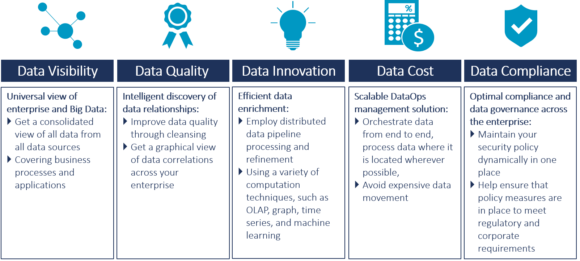Nowadays, Data is being gathered from IoT devices, social media and almost any (business) application we are using in our daily life. Data is basically available everywhere and accessible to everybody at any time. Often companies already store big data in data lakes, but do not use it as a competitive advantage. How about your company? SAP Data Hub is a key enabler for innovative data management, by combining data from different sources to gain new insights.
Lack of Enterprise Readiness for Big Data Analytics
Organizations traditionally keep applications for Big Data (e.g. Social Media Analysis Software), with exponential growth of volume and applications for Enterprise Data (e.g. ECC-Systems) separated from each other. Therefore, data is kept in silos or data lakes across the enterprise today. This missing linkage hinders companies to perform holistic analytics. As megatrends force organizations to offer connected, intelligent and customized products on the one hand and to still be able to come up with innovative or even disruptive solutions on the other hand, data is the central key enabler to master both challenges. But how can your company tackle the increasing number of available data and keeping the high velocity of innovation? The answer is the SAP Data Hub. “Most data scientists spend only 20 percent of their time on actual data analysis and 80 percent of their time finding, cleaning, and reorganizing huge amounts of data, which is an inefficient data strategy. With SAP Data Hub we see the potential to reversing these percentages to 20/80.” – Proof of concept at MIT
What are SAP Data Hub capabilities?
SAP Data Hub is as a new way to treat and manage structured and unstructured data in complex data landscapes, building the bridge between Enterprise Data and distributed data silos. It enables a consolidated view of data from all data sources (on-premises, cloud), covering business processes and applications. Employing distributed data pipeline processing and refinement using a variety of computation techniques, such as OLAP, graph, time series, and machine learning. Supporting tools are SAP Vora, Hadoop, Spark and other advanced analytics engines, that are capable of using machine learning techniques.  Figure 1: SAP Data Hub high-level Infrastructure The combination and connection of different systems and applications has never been easier. You can orchestrate data in SAP Data Hub where it is located, without migrating data, avoiding expensive data movement. Additionally, maintain your security policy dynamically, which helps ensuring that policy measures are in place to meet regulatory and corporate requirements.
Figure 1: SAP Data Hub high-level Infrastructure The combination and connection of different systems and applications has never been easier. You can orchestrate data in SAP Data Hub where it is located, without migrating data, avoiding expensive data movement. Additionally, maintain your security policy dynamically, which helps ensuring that policy measures are in place to meet regulatory and corporate requirements.  Figure 2: Main Benefits of SAP Data Hub
Figure 2: Main Benefits of SAP Data Hub
Smart Dust
Do you think that’s all theory and far down the road? Let’s put it into a specific use case. Combining Big Data and Enterprise Data is one of the most promising Data Hub use-cases. Imagining a manufacturing company which includes IoT sensors in their production lines, to gain information about different measures like temperature or pressure. Information gathered in this way provides insights on any potential problem which might occur. Wouldn’t it be great to have a real-time analysis on this data and take automatic countermeasures? With SAP Data Hub you will be enabled to have the full picture over your production machines and their real-time status. Furthermore, it is possible to connect the Data Hub to your ERP system. Leveraging the results to adjust your production planning automatically in case a specific machine is running into trouble, informing the maintenance unit and finally automatically checking for potential spare parts to be ordered. The benefit is a higher efficiency in your production, a reduced number of defective outcome and a minimized probability of major machine failures. There are many potential similar use-cases, which result in increased production efficiency, customer satisfaction or increased revenue through new data insights. By using SAP Data Hub, you can overcome data silos, process data where it resides, avoid expensive data movements, scale data operations and explore new ways to connect data from various sources. You can make profound decisions, use analytics services Machine Learning and advanced data analytics and simplify the orchestration of complex data processes while providing governance across diverse landscapes including big data stores, enterprise data stores, applications and cloud solutions. With Camelot´s help you can leverage the SAP Data Hub to gain valuable insights and finally use your gathered data to achieve competitive advantage.
We would like to thank Biagio Clemente for his valuable contribution to this article.
